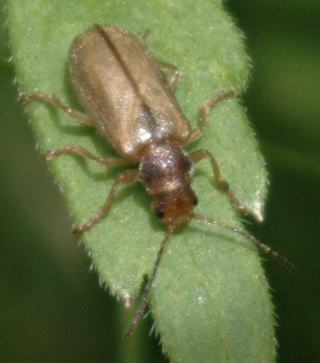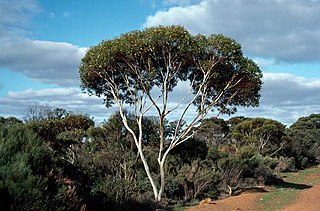
The Sapotaceae are a family of flowering plants belonging to the order Ericales. The family includes about 800 species of evergreen trees and shrubs in around 65 genera. Their distribution is pantropical.

Chrysophyllum cainito is a tropical tree of the family Sapotaceae. It is native to the Isthmus of Panama, where it was domesticated. It has spread to the Greater Antilles and the West Indies and is now grown throughout the tropics, including Southeast Asia. It grows rapidly and reaches 20 meters in height.

A bark beetle is the common name for the subfamily of beetles Scolytinae. Previously, this was considered a distinct family (Scolytidae), but is now understood to be a specialized clade of the "true weevil" family (Curculionidae). Although the term "bark beetle" refers to the fact that many species feed in the inner bark (phloem) layer of trees, the subfamily also has many species with other lifestyles, including some that bore into wood, feed in fruit and seeds, or tunnel into herbaceous plants. Well-known species are members of the type genus Scolytus, namely the European elm bark beetle S. multistriatus and the large elm bark beetle S. scolytus, which like the American elm bark beetle Hylurgopinus rufipes, transmit Dutch elm disease fungi (Ophiostoma). The mountain pine beetle Dendroctonus ponderosae, southern pine beetle Dendroctonus frontalis, and their near relatives are major pests of conifer forests in North America. A similarly aggressive species in Europe is the spruce ips Ips typographus. A tiny bark beetle, the coffee berry borer, Hypothenemus hampei is a major pest on coffee plantations around the world.

Prunus serrulata or Japanese cherry is a species of cherry tree that grows naturally in Japan, China, Korea, and Vietnam, and it also refers to a cultivar produced from Prunus speciosa, a cherry tree endemic in Japan. Historically, the Japanese have developed many cultivars by selective breeding of cherry trees, which are produced by the complicated crossing of several wild species, and they are used for ornamental purposes all over the world. Of these, the cultivars produced by complex interspecific hybrids based on the Oshima cherry are also known as the Cerasus Sato-zakura Group.

The rain beetles are a group of beetles whose extant species are found only in the far west of North America. They spend most of their lives underground, emerging in response to rain or snow, thus the common name. Formerly classified in the Scarabaeidae, they are currently assigned to their own family Pleocomidae, considered the sister group to all the remaining families of Scarabaeoidea. The family contains a single extant genus, Pleocoma, and two extinct genera, Cretocoma, described in 2002 from Late Cretaceous deposits in Mongolia, and Proteroscarabeus of Late Cretaceous China.

The Synetinae are a small subfamily within the leaf beetle family (Chrysomelidae). They are found entirely within the Holarctic, mainly in North America but also appearing in parts of Europe and Asia. The subfamily contains only two genera, Syneta and Thricolema, with a total of 12 described species. The group is sometimes treated as a tribe of Eumolpinae, where they are known as Synetini.

The Siberian elm cultivar Ulmus pumila 'Dwarf Weeper' was discovered in a western Illinois garden and sold by the Arborvillage Nursery Holt, Missouri.

Faidherbia is a genus of leguminous plants containing one species, Faidherbia albida, which was formerly widely included in the genus Acacia as Acacia albida. The species is native to Africa and the Middle East and has also been introduced to Pakistan and India. Common names include apple-ring acacia, white acacia, and winter thorn. The South African name is ana tree.
Thricolema is a genus of leaf beetles in the subfamily Synetinae. It contains only one species, Thricolema anomala, known from California and Oregon in the United States. Thricolema resembles Syneta, except that the adult females of Thricolema have simple tarsal claws, whereas adults of both sexes of Syneta have bifid claws. The body of an adult is elongated and fibrous. Adults are associated with Calocedrus decurrens.

Syneta betulae is a species of beetle from the family of leaf beetles, subfamily Synetinae.

Syneta is a genus of leaf beetles in the subfamily Synetinae. There are about 11 described species in Syneta. The genus is entirely holarctic in distribution, with species appearing in North America, Siberia, East Asia and Northern Europe.

Gambeya albida, commonly known as white star apple, is a forest fruit tree commonly found throughout tropical Africa. It is closely related to the African star apple which is also common throughout West Africa. Some schools of thought feel that they may just be a variety of the same species. Also in the family is the purple star apple.

Eucalyptus albida, commonly known as the white-leaved mallee, is a mallee that is endemic to the south-west of Western Australia. It has smooth white or greyish brown bark, lance shaped adult leaves, and flowers in groups of between seven and eleven. The flowers are creamy white and the fruit are hemispherical to cone-shaped. The juvenile leaves that are often retained on mature plants are arranged in opposite pairs, egg-shaped to heart-shaped and bluish grey.
Syneta extorris is a species of leaf beetle. It is found in eastern North America.
Syneta hamata is a species of leaf beetle. It is found in western North America.
Syneta simplex is a species of leaf beetle found in North America. The species includes the two subspecies Syneta simplex simplex, which lives at elevations considerably below timberline and feeds on Garry oak, and Syneta simplex subalpina, which is found near timberline in Washington and British Columbia and feeds on alpine fir.
Syneta seriata is a species of leaf beetle. It is found in North America. It feeds on California live oak and California black oak.
Syneta pilosa is a species of leaf beetle. It is found in North America.
Glyptoscelis albida is a species of leaf beetle. It is found in western North America.











